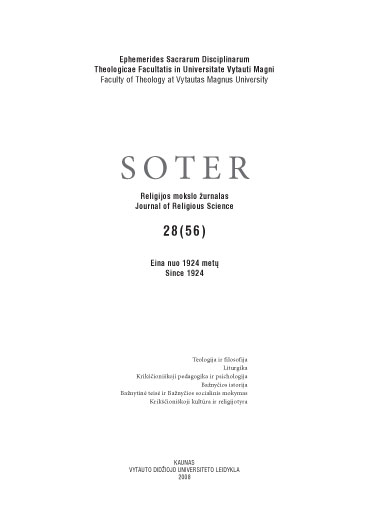Lietuvos piligrimų vertybinės nuostatos
VALUE ATTITUDES OF LITHUANIAN PILGRIMS
Author(s): Darius LiutikasSubject(s): Christian Theology and Religion
Published by: Vytauto Didžiojo Universitetas
Keywords: piligrimai; vertybės; tapatumas; kelionės motyvai; pilgrims; values; identity; travelling motives.
Summary/Abstract: Every pilgrimage embodies three main elements: a person with his values and identity, the journey itself and its destination. A religious pilgrimage is an expression of religious identity and its ritual dimension. People identify themselves with particular religious places, which become culturally constructed shrines. According to the calculations and the data of research, we suppose that in average about 300 thousand Lithuanian pilgrims annually go on pilgrimages (including journeys on feast days and journeys to foreign shrines). This is about 8,9 percent of Lithuanian population. The article presents the data from the survey of Lithuanian pilgrims. Inquiry with questionnaire took place from July 2007 to April 2008. 400 hundred pilgrims from 14 to 74 years old were questioned during the survey. The inquiry took place in organized groups, which had gone to sacred places and events in Lithuania or abroad. The destinations of pilgrimages were Šiluva, Pivašiūnai, the Gate of Dawn, the Hill of Crosses in Lithuania and also Lourdes, Medjugorje, Taize, Geneve (Te New Year celebration of Catholic youth), monasteries in the Middle and Eastern Europe. Pilgrims questioned in Lithuania travelled to pilgrimage centers with charter buses, all centers were distributed more than 50 kilometers from pilgrims’ departure places. Pilgrims were from various geographical places of Lithuania (Vilnius - 31 percent, Kaunas - 24 percent, Klaipėda, Šiauliai, Panevėžys - 12 percent, other cities and towns with the population from 2 thousand to 100 thousand inhabitants - 24 percent, and areas with smaller than 2000 population - 9 percent.). The surveys indicate that about half of pilgrims go individually by car to pilgrimage places, one third of them - sometimes individually, sometimes in organized groups and others only in organized groups by bus. Strong religious identity is typical to Lithuanian religious pilgrims, however this identity represents Catholic doctrine optionally. We can define three factors in the analysis of pilgrims’ ideological attitudes. Acknowledgement of supernatural world, which is unknown, frightening and not appealing to mundane laws, is the first factor. The main features are belief in the existing supernatural world, belief in evil spirits, belief in the life after death and belief in miracles. The belief in God, in Redemption, in forgiveness of sins and in apparitions of Virgin Mary is the main features of the second factor, which we can call traditional religion. The significance of religion in life is common to this factor. The belief in reincarnation, natural powers, deities and fate belong to the third oriental-pantheistic factor. Religious pilgrims greatly differ according to the degree of religiosity from average Lithuanian position defined in various surveys according to different dimensions of religious identity. The five different models of journey conception we could distinguish following the analysis of pilgrims’ motives and values.
Journal: SOTER: religijos mokslo žurnalas
- Issue Year: 56/2009
- Issue No: 28
- Page Range: 167-186
- Page Count: 20
- Language: Lithuanian

